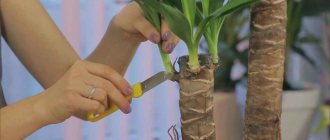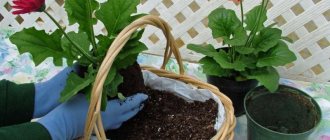Azalea - flowering rhododendron: description of the species
Azalea is a plant from the genus Rhododendron of the heather family. Two varieties are suitable for growing indoors:
- Indian - in indoor conditions it grows from 40 to 60 cm. It forms funnel-shaped flowers, collected in inflorescences of 2-3 pieces. The formation and opening of buds continues from December to May. When other indoor plants are at rest.
- Japanese - most often grown in open ground, but cultivation at home is also possible. The height of the indoor plant is from 30 to 50 cm. Flowers, depending on the variety, reach from 2.5 to 7.5 cm in diameter. There are simple, terry or semi-double.
Azaleas of any variety form a compact bush with short shoots and densely spaced oval, dark green leaves. Based on the time of bud formation, plants are divided into 3 groups:
- early flowering – December-January;
- average flowering period - January-February;
- late flowering - February-March.
Indian azalea: indoor plant
The flowers are quite large - up to 5 cm of various colors, they can be simple, double, corrugated or not. This species is the ancestor of most indoor azaleas. Interesting fact: all the flowers on the plant open at the same time. By choosing the right varieties, you can achieve constant flowering.
Indian azalea flower: photo
Japanese azalea
A rarer species for indoor floriculture. The flowers are smaller than those of the Indian azalea, but it can be planted in open ground.
Japanese azalea flowers: photo
The adaptation period for azaleas after the store
For a plant to grow well, it needs to get used to new conditions. To do this, the gardener inspects the soil for the presence of mold. If there is a disease, the flower is treated with anti-fungal drugs. Next, the azalea is accustomed to a different habitat.
It is not recommended to place the plant in the sun, as the flower must get used to it.
Quarantine condition
Having brought home a crop, which, by the way, is finicky to grow, you cannot add it to existing pets in the house. Even if an azalea looks beautiful, this does not mean that the plant is healthy and is not in danger. To do this, the flower is placed in a separate room, creating a quarantine for at least two weeks. If after a while no problems arise, the plant is placed with the rest of the green mass.
When is a transplant necessary?
If possible, it is better to replant the azalea immediately after purchase.
In flower shops, plants are sold in shipping pots with scanty soil. You cannot be sure that the plant has received proper care and has a healthy root system. Ideally, the first transplant of not only an azalea, but also another flower, is best done immediately after purchase.
However, if the azalea is blooming or in the budding period, replanting may lead to the shedding of inflorescences. In this case, you can wait to replant until it fades. Of course, when the condition of the soil does not raise suspicions. If the soil in the pot is too flooded, there are traces of salinity and mold, it is better to transplant the azalea into fresh soil. Before this, most of the blooming buds should be removed.
Healthy azaleas that are grown at home are then replanted regularly. Young - annually, adults - once every 2-3 years. When replanting, you need to take into account that a special microflora forms around the root system of the azalea. Its violation can lead to the death of the flower. Azaleas are not replanted in winter and during the flowering period. The best time to change the soil is spring.
After the purchase
After purchasing the plants, they ask themselves the question: how to plant azaleas at home? Performing a transplant after purchase is a mandatory procedure. For transportation and sale, suppliers place plants in a special substrate in which the plant is uncomfortable to grow for a long time.
On a note! Replanting azaleas at home is possible only after an adaptation period.
Flower growers advise purchasing ready-made soil designed specifically for azaleas. The flower is extremely demanding on the composition of the soil and the slightest disturbance in the proportions can at least lead to the development of diseases. It is difficult to prepare the correct substrate at home.
Replanting after purchase
Transplantation is carried out using the transshipment method. The azalea is thoroughly cleaned of the soil mixture and planted in a well-drained container. Watering after transplantation is carried out directly under the root.
After flowering
Transplanting an azalea after flowering includes the following activities:
- First, the buds are cut off.
- A special drug is added to the purchased soil to protect the plant from fungal spores - trichodermin.
- The azalea pot is filled 1/3 full with any drainage material to avoid rotting of the root system.
- To increase the acidity level of the soil, a layer of pine bark is laid on the drainage.
After flowering
How to replant an azalea at home without damaging the root system? The procedure is performed as carefully as possible:
- The plant is removed from the pot. At this stage it is important not to damage the roots.
- The flower, together with a dense earthen lump, is soaked in any stimulating solution for 30-40 minutes.
- At this stage, the root shoots are carefully examined. If there are diseases or damage, they are cut off with a sharp knife.
- After processing, move it to a new pot and cover it with soil for azaleas.
- The place for the flower should be maximally illuminated and located away from heating devices. The adaptation time directly depends on the variety and primary condition of the bush.
Attention! A diseased root system will not allow the azalea to develop normally.
Reproduction of azaleas by dividing the bush
In this way, you can propagate an azalea that has many young shoots and a well-developed and healthy root system. The procedure is carried out in the spring, when the crop activates not only its growth, but also its defenses.
Reproduction of azaleas by dividing the bush is risky by damaging the small, but extremely important roots for the plant. Therefore, the procedure should be carried out very carefully using a sharp, disinfected knife.
After being transplanted into their own pots, the separated parts of the azalea regain their strength for at least a year and require special attention and care.
How to properly replant an azalea indoors
Many people are interested in how to properly transplant an azalea at home. To do this, you need to prepare the right pot and soil.
Selection and preparation of soil
Azaleas need soil with high acidity parameters. Therefore, it is important to choose the right substrate for the plant. It should be quite loose and allow air to pass well to the root system. To maintain the desired parameters, the plant must be periodically watered with a solution of citric acid.
It is best to make the soil yourself. To do this, you need to take the following ingredients in a ratio of 2:1:1:1:1:
- special substrate for azaleas;
- small tree bark;
- fresh or dry sphagnum moss;
- fine sand;
- charcoal and vermiculite.
You can also mix coniferous soil, peat and sand in a ratio of 2:1:1. A composition based on pine needles, high peat, sand and leaf soil will be no less effective. They are mixed in a ratio of 2:3:1:1.
The prepared substrate must be watered with a special product - “Fitosporin” and its analogues. You can also process the mixture in the oven or steam it over boiling water.
Important! Untreated soil can be a source of pests or fungi that will lead to contamination of the crop. Therefore, the substrate must be disinfected.
Ready soil
Beginners in floriculture replant azaleas in store-bought soil: “Fasco”, “Udmurttorf” or “Permagrobusiness”. This method of transplantation is safe for the flower, but provided that, in addition to other components, the composition contains coniferous soil. Ready-made soil for azaleas has all the necessary components for healthy root development and flowering
Before purchasing, carefully study the label. If the substrate contains a complex of microelements and minerals, do not fertilize the flower for 2-3 months after transplantation. This soil mixture is suitable for an adult plant. Young or vegetatively propagated flowers are planted in soil where nutrients are scarce.
The date of manufacture can be determined by the inscriptions on the label. This information will not hurt if the gardener buys soil for future use: the fresher it is, the better.
Do-it-yourself soil preparation
Experienced gardeners plant azaleas in a soil mixture prepared independently. It should be crumbly to allow air to pass through to the root system. There are three recipes for good soil:
- 1 part sand and peat, 2 parts coniferous soil;
- 1 part each of sand and leaf humus, 2 parts of humus from fallen needles of spruce, fir, larch, pine and 3 parts of peat collected during the decomposition of sphagnum moss or cotton grass with the participation of moisture;
- in equal proportions take special soil for azaleas, sphagnum moss, steamed bark, vermiculite, charcoal, perlite.
Whatever method of preparing the substrate is chosen, before transplanting, remove all excess from it (twigs, pebbles, pieces of polyethylene) and disinfect it. To do this, use “Fitosporin”, fry it in the oven or steam it in a water bath for 30 minutes with periodic stirring. Without disinfecting it, they are faced with damage to the plant by pests and fungal diseases.
Without taking care of the cleanliness of the soil in advance, you can either face the death of the flower or take a long time to treat it.
Substrate based on universal soil mixture
Based on ordinary soil for indoor flowers, a good mixture is prepared that is suitable for anthurium. Typically, such soil already contains a sufficient amount of peat, which gives it a light and loose structure and also creates weak acidity.
To such a substrate add pine bark crushed to a medium sliver. As a result, the soil becomes more drained, moisture-absorbing with excellent air permeability.
Soil-based substrate for azaleas and orchids
Another simple method of preparing a suitable composition is to enrich purchased soils for Azaleaceae and Orchids with a number of additional components. The complete list of components used will be as follows:
- ready-made soil for azaleas;
- orchid substrate;
- sphagnum moss;
- coarse charcoal.
Additional Information! All elements are mixed in equal parts. The soil will be quite nutritious and corresponding in structure to the needs of the anthurium.
Soil from components collected in natural conditions
Experienced flower growers use components collected with their own hands in accessible places to create soil mixtures: in the garden, in the forest, in the field. In natural conditions you can find such components as:
- peat;
- leaf humus;
- fallen pine needles or topsoil from a coniferous forest.
Before mixing these elements, they are subjected to disinfection treatment. Steaming is more suitable for peat and humus, and pine needles should be washed with boiling water and kept in a solution of potassium permanganate.
It would not be superfluous to add sphagnum, coal and dry pine bark
Selection of pot
The choice of pot for azaleas is of great importance. It should not be very large in size so that the roots feel as comfortable as possible. It is best to choose a container 2 cm larger than the previous one. This will help the root system to settle in faster and minimize the risk of soil flooding.
It is desirable that the pot has low edges and is wide enough. The root system of the plant is characterized by horizontal development, so it requires optimal conditions.
The pot material can be anything. Plastic or ceramic are perfect. At the same time, natural container is still more preferable. There should be drainage holes at the bottom to remove excess moisture.
Drainage
Without drainage, water will stagnate, as a result of which the soil can become acidic and cause rotting of the root system. The following are used as drainage components:
- crushed brick;
- expanded clay or river pebbles;
- small broken crushed stone.
This is interesting: White-veined spurge: planting, home care, growing and pruning
Passing through the drainage layer, water is removed from the pot through special holes.
Renewal root pruning
Carrying out sanitary pruning has a good effect on the condition of the crop. To begin with, the flower with a lump of soil needs to be pulled out of the pot. It must be inspected for external damage and dead fragments removed.
You should not try to separate a dense lump of earth with your hands. This can cause root damage. Before trimming, they need to be soaked in a warm Zircon solution. Then you can carry out renewal pruning. To do this, the roots on each side should be trimmed by 1-1.5 cm.
Azalea division
By dividing the bush, the plant you like is propagated. Also, the procedure can be carried out due to the impressive size of the bush. How to plant azaleas at home?
To do this, you need to carefully remove the flower from the pot, inspect the roots and, if necessary, trim off diseased or dry fragments. The earthen lump needs to be cut into several fragments.
Important! There must be at least 1 shoot left on each fragment. Each plant needs an individual pot.
Planting in another pot
The step-by-step process of planting a plant looks like this:
- A drainage layer 3 cm thick is poured onto the bottom of the container. It should consist of small stones.
- You need to put wood chips, sand or pine bark on top. The thickness of this layer should be 2 cm.
- Then sprinkle the layer with Trichodermin, which helps to avoid the development of fungi and rot.
- Pour soil on top and distribute evenly throughout the container.
- Remove the azalea from the container with the growth stimulator solution, squeeze out the earth a little and let the liquid drain.
- Place in the center of the prepared soil.
- Sprinkle fresh soil around the azalea. In this case, the root collar of the crop should not be touched.
- Gently add soil to the sides and compact it slightly.
- Lightly water the soil with the solution in which the roots were soaked.
Important! After replanting, it is forbidden to water the bush abundantly. The root system dries more slowly than the soil, so there is a risk of root rot.
Do I need to replant an azalea?
Changing the soil and flowerpot is necessary if necessary. A three-year-old crop is replanted once a year. If the plant is older, the procedure is done 2 times a year. The flower is replanted when the roots grow profusely or the soil rots. Immediately after purchase, it is better not to disturb the flower for as long as possible. First there must be an adaptation period.
When to replant an azalea
Usually the flower is replanted in the spring. Before cleaning the above-ground part, remove dry branches and leaves. During transplantation, you must not damage the roots; if possible, completely replace the old substrate with a new one.
Choosing a pot and substrate
Experienced gardeners recommend purchasing ready-made mixtures in stores. However, if it is not possible to buy soil, then a mixture of pine needles and peat is used.
When choosing a flowerpot for a flower, give preference to deep and wide flowerpots. Speaking about the material of the pots, clay and plastic containers are suitable for azaleas.
Features of transplanting azaleas in the garden
Transplanting the plant into the garden should be done in early spring - before the active movement of juices. As a last resort, you can replant the crop in early autumn. Street azaleas are characterized by a superficial location of the root system. Therefore, it does not need a deep hole for planting. The depth should not be more than 50 cm, and the width - 70-80.
It is worth considering that the use of lime chips changes the acidity parameters. This negatively affects the development of the bush. When planting, it is worth considering that the root collar of the plant should be above the surface of the earth. After planting, the soil must be compacted and watered.
Soil for azalea garden
A garden azalea by itself can decorate the entire yard; the bush is almost completely covered with flowers, and the leaves underneath are not even visible. Having decided to plant such a beauty in your garden, you should keep in mind that the acidity of the soil for azaleas should be high; it will not grow in slightly acidic soil, moreover, it will not even be accepted.
However, this does not mean that you need to give up the idea of growing such beauty, you just need to work a little on the soil. Its top layer can be enriched with peat, special fertilizers, or simply replaced with ready-made purchased soil “For rhododendrons and azaleas.”
How can you acidify soil for azaleas?
As mentioned above, an acidic environment is required by microorganisms that support vital processes occurring in the plant. An alkaline environment is detrimental to both symbionts and azaleas.
The composition should contain coniferous soil, as it is a natural acidifier. When purchasing a mixture for azaleas, it is important to pay attention to this component.
You can increase acidity by adding pine bark to the substrate. Before use, it must be washed, dried and crushed. Only after this can the bark be mixed into the soil.
If it is not possible to purchase pine bark, it is recommended to go to the store and ask a specialist to select a special acidifier that is used to increase the acidity of the soil. Use only in accordance with the instructions.
To ensure that the flower does not lose its attractiveness after purchase, it is necessary to replant the azalea in properly prepared soil, since good soil is the key to the long life of indoor rhododendron.
Is it possible to plant when flowering?
It is not recommended to disturb the azalea during flowering. When stressed, it can lose buds and even shed leaves. However, there are exceptions to every rule.
A transplant is needed in the following circumstances:
- after the purchase;
- if the azalea is flooded;
- if the pot size is insufficient.
Carefully! Transplantation during flowering is carried out using the transshipment method, without affecting the roots. Dividing the bush for planting during this period cannot be done.
Typical mistakes during transplantation
Failure to follow the transplanting rules can lead to infection of the plant with a fungus or invasion of harmful insects. If you overwater your azalea, there is a risk of rust or root rot. Any fungicide or copper sulfate solution helps perfectly in the fight against the disease.
If pests appear on the plant: aphids, spider mites or whiteflies, timely treatment with an insecticidal agent will help. If after transplanting an azalea, home care does not allow you to get buds, then the reason is:
- unsuitable soil for growing;
- poor watering and spraying regime;
- dry air;
- non-compliance with fertilizing standards.
Growing azaleas from seeds
Getting flowering azaleas from seeds is extremely difficult and troublesome, but possible. To do this, small seeds are mixed with dry sand and sown on the surface of the substrate. The best time for the procedure is spring.
Future plants spend three weeks under the film at a temperature of 18–22 °C and constant humidity within 90–100%. They are regularly sprayed and ventilated, preventing drying out or mold. When real leaves form on the seedlings, it’s time for the azaleas to take off. And seedlings that have reached a size of 10–12 cm are transplanted into their own pots.
Caring for azaleas at home
If you care for an azalea grown at home correctly, it will bloom very profusely, beautifully and for a long time.
Lighting
After the flower is purchased, it needs to find the most suitable place in the house. This plant is light-loving, but it needs protection from the scorching direct rays of the sun. In this regard, to grow it, you should choose a window sill with an eastern orientation; a window located on the north or west side is also suitable. It is also important to take into account that the lighting must be diffused, but azalea feels quite good in partial shade. In October and November, when the plant begins to form buds, it will need a lot of light. Good lighting can be provided by illuminating the flower with fluorescent lamps.
This is interesting: Care and cultivation of milkweed Mile at home: how to plant, water, fertilize, seed
Temperature
The correct temperature regime also plays a very important role when growing a crop such as azalea. This flower, grown at home, is not a heat-loving flower. The optimal temperature for growing it is from 15 to 18 degrees. During the period of bud formation, it will need a lower temperature - 10–12 degrees. If you maintain the correct temperature when growing azaleas, the flowering will be lush, spectacular and long-lasting. In summer it is especially difficult to maintain the required temperature. Experienced gardeners recommend moving it to the balcony at this time, but it should not be located on the south side. If the room has air conditioning, then you should try to ensure that the air temperature in it is no more than 20 degrees.
Humidity
This plant requires high air humidity. Therefore, it must be sprayed relatively often from a spray bottle, and for this, cool water is used. During the flowering period, spraying the bush should be done with great care because if moisture gets on the surface of the delicate flowers, they may begin to darken. Also, to increase air humidity near the plant, it is recommended to place several open containers filled with water. In the summer, if desired, the azalea can be moved to fresh air, for example, place it in the garden. In winter, when the heating season begins, maximum attention must be paid to the level of air humidity.
Top dressing
Rather, stimulants will help you adapt. Zircon is especially popular in floriculture. In case of transplantation, it is used after 4-5 days, then the same schedule is followed. Like any living creature, azalea needs a complete, balanced diet. But it is important to remember that a light diet is better than constant overfeeding. During the period of active vegetation, the formation of photosynthetic tissue, a lot of nitrogen is required, but its excess burns the root system, especially weak ones. Fertilizers should never contain chlorine.
To increase stress resistance, ready-made preparations are used, for example, Epin, HB-101, Ecogel-anti-stress. Each of them is provided with detailed instructions and has its own advantages and disadvantages. So, Epin solution is used only for spraying, while other mixtures can be watered and sprayed.
How to water
Proper watering is also very important when growing indoor azaleas. It has a strong influence on both the growth and vegetation of such a shrub. It is particularly demanding when it comes to watering, and to avoid the death of the bush, you must strictly follow the following rules:
- It is necessary to water the plant systematically, and during the flowering period watering should be very abundant;
- The earth ball in the pot should under no circumstances dry out, but if this happens, then the plant along with the pot must be immersed in a container filled with slightly lukewarm water for 2 hours, during which time the required amount of moisture will be absorbed into the soil;
- the substrate should be slightly damp all the time;
- excessive moisture of the substrate must also be avoided;
- It is necessary to pour out the drained water from the pan, otherwise the rhizome may rot;
- if tap water is used for irrigation, then it must stand for at least 2 days, during which time the chlorine will evaporate and will not harm the bush;
- It is best to water the azalea with melt water, which should be cool;
- To make flowering more abundant, the bush needs to be watered once every 2 weeks (not more often) with a mixture consisting of settled water and 2 or 3 drops of lemon juice.
Diseases and pests of azaleas
Diseases appear due to improper care:
- insufficient watering of the plant,
- sun exposure,
- increase in room temperature,
- where is this flower located?
- lack of light,
- wrong soil.
Azalea diseases
- If the leaves are wilted, yellow, or falling off, the cause is lack of watering of the plant or exposure to the sun. If you start following the rules of watering, spraying and lighting, the problem will disappear.
- If rust or gray rot appears, then it is necessary to create a comfortable temperature for the flower to exist and cut off the damaged leaves.
- If its flowers only turn yellow, begin to fade and fall off, it means that the watering is of poor quality. This can be corrected by watering with boiled water and specialized fertilizers.
- Due to an excess of moisture in the soil, azaleas are most often affected by late blight, which leads to the death of the indoor plant.
Pests
Spider mites, scale insects, and strawberry mites are pests that can ruin indoor azaleas. To combat it, it is necessary to treat the home flower with special means. First you need to treat the foliage with a soap solution, then rinse with warm water and then spray with a purchased product (for example, Actellik solution).
Sources
- https://ufermer.com/komnatnye-rasteniya/azaliya/kak-peresadit-i-vyrastit-v-domashnih-usloviyah.html
- https://sazhaem.info/plants/blooming/asalia/peresadka-i-razmnozhenie-azalii.html
- https://tsvetydoma.ru/komnatnyie-rasteniya/tsvetushhie-komnatnyie-rasteniya/peresadka-azalii-kogda-i-kak-provodit.html
- https://pocvetam.ru/komnatnye-rasteniya/tsvetushchie/kak-peresadit-azaliyu.html
- https://greensotka.ru/tsvetushchie/kak-peresadit-azaliyu.html
- https://felisov.ru/komnatnye-rasteniya/v-kakoj-gorshok-peresadit-azaliyu.html
- https://stroy-podskazka.ru/azaliya/kak-peresadit/
- https://pocvetam.ru/komnatnye-rasteniya/tsvetushchie/grunt-dlya-anturiuma.html
- https://DSad12.ru/cvety-i-rasteniya/peresadka-azalii-posle-cveteniya.html
- https://rastenievod.com/azaliya.html
- https://buton.info/azaliya/kak-peresadit-azaliyu-v-domashnih-usloviyah
[collapse]
Planting - not growing: proper care
The transplanted azalea must be provided with the correct microclimate and careful care. The plant will successfully master the new soil and continue to grow if the following conditions are met:
- Bright but diffused light. You cannot place the flower on a south window or next to heating appliances.
- Humidity level less than 60%. If the indicators are lower, then the pot can be placed on a tray with expanded clay filled with water.
- Air temperature 16-18°C. In a warmer room, the plant may overheat.
- The first watering is carried out 3-4 days after transplantation. Use settled or filtered water with the addition of Zircon (4 drops per 1 liter). To prevent the foliage from drying out, at this time it is lightly sprayed with a spray bottle.
For your information! You cannot feed a transplanted azalea for 2 months. Roots that have not taken root will get burns from the fertilizer.
Compliance with all recommendations will help the azalea to safely survive the stress of transplantation and continue development. If the technology of the procedure and subsequent care has not been violated, then after 15-20 days the plant will give new leaves. And then, in due time, it will begin to bloom.
5 / 5 ( 1 voice )
Preparing for landing
To replant azaleas after purchase, you will need wide plastic or clay pots, flowerpots or containers larger than the previous ones. Drainage is laid at the bottom, and pine bark is placed on top of it - it is needed to increase the acidity of the soil. The soil should be slightly acidic, specifically designed for azaleas. The best option is to buy nutrient soil with the appropriate mark in the store and add baking powder.
To replant azaleas after purchase, you will need wide plastic or clay pots, flowerpots or containers larger than the previous ones.
You can also use heather soil, which is highly acidic, light and loose, or a mixture of high-moor peat and pine needles. Whenever replanting azaleas, it is advisable to add trichodermin to the soil mixture - it will protect the plant from fungi and rot. To soak the roots you will need zircon, epin and other materials.
How to prevent a flower from dying
Azalea in packaging
When you have made your long-awaited purchase and brought an azalea to its new home, you should not rush to take it out of the store packaging. It is better to leave the plant alone for about half an hour so that the flower gets used to the microclimate of the apartment.
It is important to decide on the permanent location of the plant. Here are some recommendations:
- A space with good lighting, but without direct sunlight;
- Coolness – approximately +16-18;
- Humidified air.
It is very important to examine the soil of the azalea - to do this, you need to remove it from the flowerpot. In stores, they often fill the flower with water to make it look fresher.
What to do if the soil is too wet:
- Remove the flower from its pot and wrap the roots and soil with paper that absorbs moisture well;
- Repeat this action until the soil is sufficiently dry, but this must be done extremely carefully due to the fragility of the roots.
If the plant is too dry:
- It needs to be placed in a container of water directly in the pot for about sixty minutes. The water should reach the edges of the pot;
- Then you need to take out the flower and allow the excess moisture to go away - to do this, place the pot in a saucer or a special tray lined with expanded clay so that the soil and liquid no longer combine;
- You should not replant the flower immediately, especially if the flowering period has begun.
Differences for indoor and outdoor plants
Naturally, there are some differences in transplanting garden varieties and indoor ones; they also grow in different conditions.
- When a garden Azalea seedling is removed from a purchased container, the soil from the roots must under no circumstances be shaken off, and in the case of indoor Azalea, part of the old soil is removed.
- After planting outdoor Azaleas, you need to make a circle around the trunk; when planting a house plant, the soil on top is flat.
- For garden Azaleas, a layer of mulch from pine needles or wood chips is required; if kept indoors, this is not necessary.
How to solve the problems of incorrect content?
Improper care of an azalea can destroy it in a matter of days. However, with a certain amount of effort, you can save even a plant in a state of extreme stress.
The right choice of location, good soil, fertilizing and treatment with growth stimulants, as well as ensuring proper watering and air humidity are factors that can revive an indoor Rhododendron that has suffered from errors in caring for it (learn more about how to care for azaleas at home , available here).
Indoor azaleas are truly regal creatures, capricious and demanding of the attention of their owner. However, these miniature shrubs can easily be kept indoors and delight the eye with healthy foliage and abundant flowering.
It is only important to carefully study the conditions of keeping plants of this species, carefully approach the choice of the purchased specimen and provide it with proper care during the adaptation period
Azalea is gaining increasing popularity among gardeners. How to propagate, prune this plant and what are the subtleties of caring for rhododendron in the fall - read in our materials.
How to moisten the soil after purchase: step-by-step instructions
Let's look at the detailed watering instructions.
Read about how to provide the necessary care for your azalea at home after purchase.
What should the water temperature be?
As a rule, it is preferable to water azaleas with water at room temperature, which is two to three degrees higher than the soil temperature. Then the plant will not experience stress and will not receive damage. Watering with ice water is strictly contraindicated: because of it, development slows down, the flower gets sick, and the delicate roots deteriorate irreversibly. On hot days, it is better to cover the pot with ice or snow, then irrigation will be carried out softer and more accurately.
How often to moisturize rhododendron?
Depending on the time of year and the condition of the flower, the frequency of watering may vary.
Constant moderate watering - 1-2 times a week. In hot, dry weather it can increase up to 3-5 times, and in winter, on the contrary, no more than once.
During the period of bud formation, it is correct to water the plant once every couple of days; after flowering begins, the frequency increases - but the volume decreases
It is important to monitor the condition of the soil and monitor the need for irrigation as it happens.
You could even say that the frequency of watering an azalea is determined solely by the characteristics of the land. You can easily resolve the question of whether it is time to water the rhododendron: dip your finger into the soil to a depth of 3-5 cm. If the soil is already dry, then irrigation is necessary, otherwise you can abstain.
We invite you to watch a video about how often you should water your azalea:
Dosage
There are no specifically specified and calculated volumes for watering azaleas; it all depends on the condition of the soil and microclimatic conditions. Make sure there is enough water to fully moisten the soil.
After watering, wait until excess moisture drains into the pan: it must be removed, protecting the roots from possible rotting. Rhododendron loves moisture, but is by no means a swamp plant. Therefore, the soil in which it grows must be sufficiently permeable.
Top or bottom, in the tray?
There are several ways in which you can water both indoor and garden azaleas (it is recommended to alternate them for more successful development of the plant):
- Filling into the pan.
For this method, a flower pot is placed in a special tray filled with water at room temperature to a level of about 1 cm. The soil itself draws in the amount of liquid it needs, but this method is associated with several nuances. Firstly, with such watering, the upper layers of the earth may not be sufficiently saturated with moisture, and secondly, if the soil is particularly loose and sandy, then there will be nothing to absorb the liquid, and the azalea simply will not receive water. This type of watering should not be used more than once every 3 days. - Top irrigation. The traditional and simplest method is to pour water into the pot from above using a watering can or other similar device. It should be taken into account here that it is not recommended for water to fall on the leaves and the stream should be directed closest to the root of the main stem. This type of watering can be carried out as often as the top layer (2 cm) of the soil dries.
- Full immersion. This drastic method is used in exceptional cases: when the soil, the plant itself, or during the replanting process is very dry. The process involves extracting a flower from the soil and immersing it in a container of water corresponding to its dimensions. For better further growth, it is recommended to add zircon (again, read the instructions carefully).
Once a week (under normal external conditions) you should spray the azalea with cool water. Fertilizers are usually introduced during irrigation during the period of bud formation and flowering, approximately once every 15 days.











